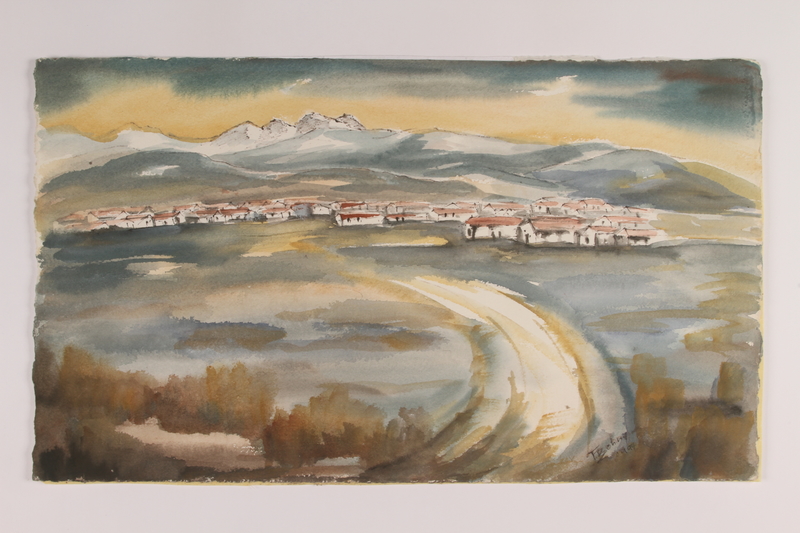August Bohny was born in Switzerland. He was trained as a primary school teacher and served a term n the Swiss military. In 1941, August went to France to serve as director of Camp McShannon, a camp for refugee children, sponsored by Americans Society of Friends (Quakers). He next administered a home for refugee children, organized by the Secours Suisse aux Enfants [Swiss Aid to Children)], an affiliate of the Red Cross. In October, he was sent to Le Chambon-sur-Lignon, France, to manage the Secours Suisse sponsored L’Abrique children’s home. In April 1942, Bohny was asked to convert the Chateau de Montiuel, near Lyon, into a home for refugee children who were being released from Rivesaltes, a French internment camp. Rivesaltes was in the unoccupied zone of France, which was governed by the collaborationist Vichy regime. Refugees from the rest of Europe were increasingly flooding France and French authorities interned thousands under deplorable conditions in French-administered detention camps such as Rivesaltes. By the spring of 1942, there were frequent round-ups and deportations of Jews to killing centers. Rivesaltes was a central transit point and several staff members form the various aid groups permitted to assist there realized the necessity of removing as many of the children as possible before they were deported. The first group of children transferred to the Chateau Montiuel were accompanied by a nurse, Friedel Reiter. She and August eventually would marry. August also worked with CIMAD (le Comite Inter-Movements apres des Evacuees).
In the fall of 1942, August returned to the Le Chambon children’s home, and Freidel began sending children there to save them from deportation. August arranged for the local College Cevenol to provide educational opportunities for the residents of L’Abrique which had primarily French Jewish children, and another home he established, Faidoli. He also organized furniture making workshop, the Atelier Cevenol, and an agricultural training school for refugees in Switzerland.
The Protestant pastor in Le Chambon, André Trocmé, and many residents of the town joined in the effort to hide Jewish children and adults, as well as political refugees. Both groups were actively sought by French and German authorities for deportation to the concentration camps in Germany and Poland. August was questioned several times by Vichy police and threatened with detention. He also assisted the French Resistance and helped smuggle people into neutral Switzerland. By January 1943, the prisoners at Rivesaltes had been deported and Friedel Reiter was sent to Le Chambon-sur-Lignon to direct the orphanage with August. They saved and cared for several hundred children. The couple lived there until the end of 1944, when all of France was liberated. In 1990, August and Friedel, and the town of Le Chambon, were recognized by Yad Vashem as Righteous Among the Nations, for their service during this period.
Friedel Reiter was born in 1912 in Vienna, Austria. Her father died in the First World War (1914-1918) and her mother was unable to care for her. As a result, she was sent to Switzerland by a Red Cross children's transport and placed in the care of a Swiss family. Friedel received training as a pediatric nurse in Zurich. War spread across Europe in 1939, and in 1941, she joined the Secours Suisse aux Enfants (Swiss Aid to Children), an organization affiliated with the Red Cross that was founded to care for children displaced during the Spanish Civil War (1936-1939). On November 12, 1941, Friedel was sent to the Rivesaltes internment camp in the unoccupied zone of France, which was governed by the collaborationist Vichy regime. The Vichy government had enacted anti-Jewish legislation, including the appropriation of Jewish-owned property. Refugees from German occupied countries had flooded France and French authorities interned thousands of Jews under deplorable conditions in French-administered detention camps such as Rivesaltes. Friedel lived in the camp barracks and suffered the same harsh conditions as the inmates, except that she had enough food to eat. Resources were extremely limited, but she did her best to provide medical care, clothing, and food for the interned refugee children, at first chiefly Jewish, Romani, and Spanish children. By the spring of 1942, the round-up and deportation of Jews to killing centers was frequent in both German-occupied and Vichy ruled France. Rivesaltes became a central transit point. The situation in the camp was rapidly deteriorating and Friedel realized the necessity of removing as many of the children as possible before they were deported. She and other rescuers were secretly aided by the commander of the camp who left lists of inmates who were to be deported on his desk in plain view. Nearly 600 children would be removed from Rivesaltes; most escaped deportation. It was during her search to find institutions in France to shelter the children that she met her future husband, August Bohny. He had established an orphanage for Secours Suisse near Lyon, Chateau Montiuel, and they met in 1942 when Friedel brought a group of children there. When he returned to the Chambon orphanage a short time later, Friedel continued to send groups of children to him. Rivesaltes was closed in November 1942, after deporting most of the Jewish internees to Auschwitz. In January 1943, Friedel was sent to Le Chambon-sur-Lignon to work as a director of an orphanage with August Bohny, and they lived there until the end of 1944. In 1990, both were recognized by Yad Vashem as Righteous Among the Nations. Friedel recorded her experiences at Rivesaltes in a wartime diary that was published in 1993. She passed away, age 89, in 2001.




